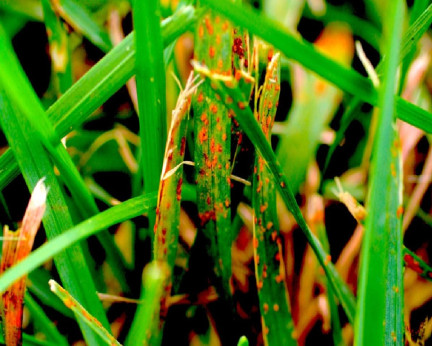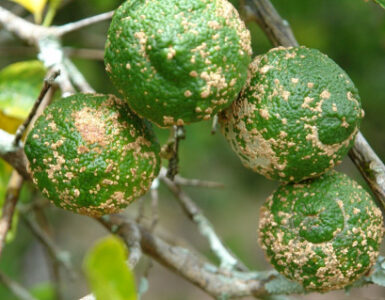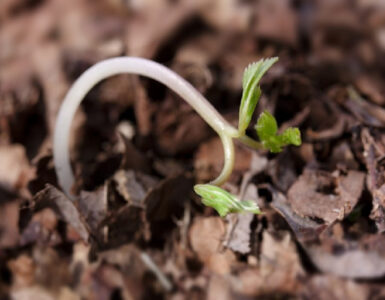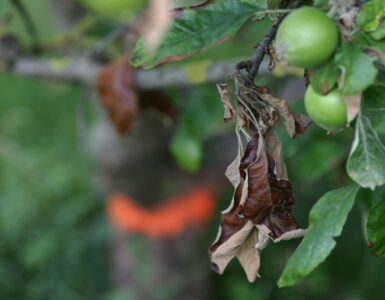A beautiful, green lawn can quickly lose its luster when orange or yellow dust starts to appear on the grass blades.
This powdery coating might be lawn rust, a fungal disease that shows up when conditions are just right—or rather, just wrong.
While it looks alarming, the good news is that lawn rust can be treated and prevented naturally.
Identification
Lawn rust is a fungal disease that affects turfgrasses [1]. It appears as orange, yellow, or even reddish-brown powdery spots on the grass blades.
If you rub the blades between your fingers, you’ll often notice a rusty residue. This powdery substance consists of fungal spores, which can easily spread.
The fungus tends to attack grass varieties like perennial ryegrass, Kentucky bluegrass, and tall fescue. However, no lawn is entirely immune.
Once the spores appear, the disease can spread quickly if conditions remain favorable.
How to Get Rid of Lawn Rust Naturally
Below are some home remedies and natural control methods for lawn rust.
1. Reduce Watering
One of the simplest ways to prevent lawn rust is to reduce watering. Overwatering keeps the lawn’s surface damp for too long, giving the fungus a comfortable place to live.
Instead, water deeply but infrequently. This encourages deep root growth and helps the grass become more resilient.
Timing also matters. Early morning (before 10 a.m.) is the best time to water your lawn [2]. Doing so allows the blades to dry out during the day.
2. Fertilize Properly
Lawn rust often shows up when your grass lacks nutrients, especially nitrogen. Therefore, applying nitrogen can help strengthen the lawn and speed up new growth.
However, avoid high-nitrogen fertilizers in the autumn. Too much nitrogen can cause excessive leaf growth, which is attractive to rust and other diseases.
3. Aerate and Dethatch Your Lawn
Aerating your lawn helps improve airflow. This process involves creating small holes in the ground so that oxygen and moisture can penetrate deeper.
You can rent an aerator or use a manual aeration tool for smaller lawns.
Dethatching is also essential. Thatch is the layer of dead grass, roots, and debris that builds up between the soil and the grass blades.
A thick thatch layer traps moisture and provides a perfect environment for fungi to grow.
4. Mow Regularly
Keeping your lawn neatly trimmed is another natural way to control turfgrass rust.
Regular mowing encourages healthy growth. It also prevents lawn fungus from spreading too easily.
However, the key is to mow correctly. Avoid cutting the grass too short, as this exposes the blades to stress, which can lead to other issues.
5. Neem Oil
Neem oil is one of nature’s best defenses against plant fungal diseases, including lawn rust.
To make a homemade lawn rust spray, mix one ounce of neem oil with a gallon of water. You can also add a tablespoon of dish soap.
Shake well and spray it evenly across the lawn.
This natural fungicide disrupts the life cycle of the rust spores and prevents them from spreading.
6. Pruning
Air circulation plays a considerable role in keeping your lawn dry and healthy.
If thick vegetation surrounds your lawn or branches shade it, your grass will likely stay damp. This is especially true in humid weather.
Therefore, prune nearby shrubs, plants, and trees. Doing so will allow more sunlight to reach the grass and help the area dry out faster after watering or rainfall.
7. Baking Soda Spray
Another home remedy you can make at home to treat lawn rust is a baking soda spray. Baking soda is an anti-fungal agent.
To make the spray, mix one teaspoon of baking soda with a quart of water. Also, add a few drops of liquid soap to help the solution stick to the grass.
Use this recipe as a guide for larger concoctions. Spray the affected areas in the early morning on a dry day.
Repeat once a week until you notice improvements.
8. BONIDE Captain Jack’s Rose Rx 4-in-1
One natural lawn rust treatment that you can purchase is BONIDE Captain Jack’s Rose Rx 4-in-1. Despite the name, it’s not just for roses—it works well on lawns, too.
This ready-to-use solution helps prevent lawn rust and other fungal diseases, such as powdery mildew and black spot.
It contains neem oil extract, which works as a natural fungicide.
9. Monterey Liquid Copper Fungicide
Another effective natural fungicide for lawn rust is Monterey Liquid Copper Fungicide RTU. This organic product uses copper to help control fungal diseases.
When sprayed onto plants, the solution forms a protective barrier that keeps infection from taking hold.
Applying it according to the container’s instructions.
Takeaway
Lawn rust may look scary, but it is usually more of a cosmetic problem than a deadly one. Still, if left untreated, it can weaken your lawn and open the door to other diseases.
The key is to get rid of it or prevent it from happening in the first place. Follow the suggestions above and see what works best for you.








Add comment